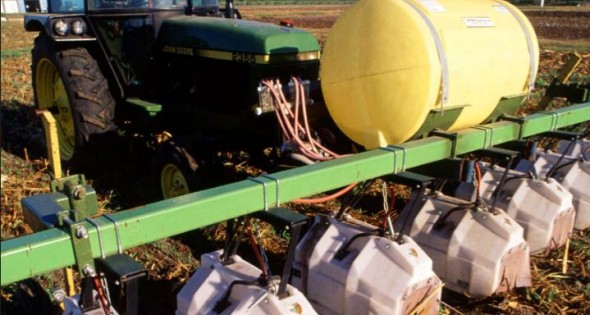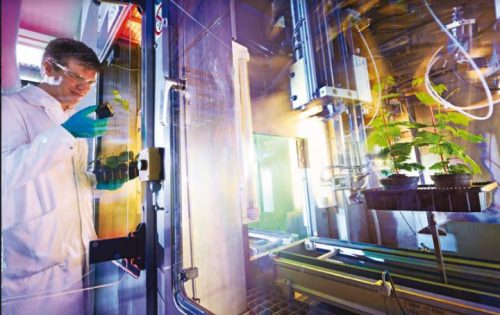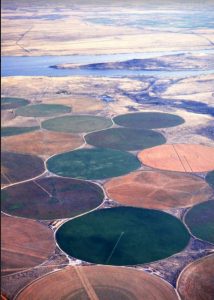
More Efficient Agriculture Techniques are Coming into the Focus
03 Jul, 2021
Over just the past 90 years, U.S. agricultural output has increased by 400 percent, and with 10 percent less land required for that result.
But demand for food is growing at the same time the supply side faces constraints in land and farming inputs, according to a McKinsey and Company report from the Center for Advanced Connectivity and Agriculture Practice.
The world’s population is on track to reach 9.7 billion by 2050, requiring a corresponding 70 percent increase in calories available for consumption, even as the cost of the inputs needed to generate those calories is rising, according to the report.
Bottom line: Farmers need to step up their game.
In recent years, many farmers have begun to consult data about essential variables like soil, crops, livestock, and weather. Yet few if any have had access to advanced digital tools that would help turn that data into valuable, actionable insights. In less-developed regions, almost all farm work is manual, involving little or no advanced connectivity or equipment.
The McKinsey report added that, in the United States, only about one-quarter of farms currently use any connected equipment or devices to access data, and that technology isn’t exactly state-of-the-art, running on 2G or 3G networks that telephone companies plan to dismantle, or on very low-band Internet-of-Things (IoT) networks that are complicated and expensive to set up. “The success and sustainability of one of the planet’s oldest industries may well depend on this technology transformation, and those that embrace it at the outset may be best positioned to thrive in agriculture’s connectivity-driven future,” the authors of the McKinsey report concluded.
Clearly now is the time to aggressively bring the agriculture industry up to speed. Strategy going forward In February, 2020, the United States Department of Agriculture (USDA) formed the Agriculture Innovation Agenda (AIA), with a goal of increasing U.S. agricultural production by 40 percent, while cutting the environmental footprint of U.S. agriculture in half by 2050.
One component of the AIA, according to the USDA, is the formulation of a U.S. agriculture innovation strategy—seeking to establish discovery goals that align with or inform both the public and private-sector research ecosystems.
The USDA report identified three major topic areas and aspirational goals for the strategy: increase agricultural production by optimizing yield and/or quality with higher input use efficiency and crop resiliency; increase production capability, by increasing agricultural production capabilities of soil, water, and air by developing and implementing sustainable farming and forestry tools and practices; and increasing market expansion and diversity, to increase market diversity and product utility of the agricultural system to expand value, reach, and resiliency.
The report further elaborated on the need for low-cost, easy-to-use, broadly dispersed sensors and biosensors across all agricultural sectors, providing real time information with high spatial resolution in areas of active cultivation.
Standards are needed for data collection, processing, and management to enable device designs that function seamlessly in the IoT. Broadband access to rural communities is needed to underpin the digital agricultural environment, including wireless networks with access to cloud-based computing. Digital tools and solutions should be scale-neutral, and useful for all types of farming/forestry systems and environments, according to the report.
Digital tools should also collect data that quantify environmental benefits to validate conservation programs and enable ecosystem service markets and carbon sequestration markets.
Automated solutions are needed that deliver precise input amounts with high temporal and spatial resolution, and/or address common issues in the agricultural production system, including worker availability and improvements in worker safety.
Automated data collection and reporting processes could enhance existing survey methods and create a data-rich environment (with protections) for further enabling the digital agricultural environment.
Blockchain or similar types of technology, coupled with sensors that detect product quality and safety, are needed to ensure transparency, traceability, and safety throughout the agricultural production system.
The report concluded by reminding industry management that it is “essential that all segments of the agricultural community work together to address these goals; they will not be solved by any one entity, and alignment of the public and private-sector innovators is essential for progress.”
The ongoing data analytics issue In their science blueprint document, with discussions about the roadmap for the USDA from 2020 to 2025, the USDA promotes the proactive sharing of data to make information and research results about agriculture and nutrition available, accessible, and usable worldwide.
As a founding partner of the Global Open Data for Agriculture and Nutrition (GODAN) initiative, USDA empowered open data conversations about agriculture and nutrition data all over the world.
USDA’s open data vision is to provide public access to all the products of USDA-funded research while protecting the confidentiality of individual and proprietary data.
They are also committed to ensuring that USDA’s public data is easy to access, interpret, and use, accelerating further scientific and public policy research. In support of this vision, USDA is developing an integrated, cloud-based platform that houses USDA’s scientific models and decision support tools.
The problem today is that so much data is being generated that the farmer is playing a sort of catch up on best methods and future planning.
But the data that is available is becoming more and more about expanding the future of food growing, making it a critical feature of tomorrow’s ag tech.
For example, delivering corn hybrids with innovative traits and genetics has been the focus for some of the 40,000 employees of Bayer Crop Science, a division of the global life science company Bayer. From pioneering insect-resistant traits and seeds designed to protect against disease to herbicide-tolerant products, Bayer Crop Science has developed solutions that help lower a grower’s risk while increasing yield and profit potential.
According to sources at Bayer Crop Science, prescriptive, “tailored” solutions are becoming more specific than ever to a grower’s environment and geography. “(We’re) bringing not only specific products, but information to growers, so they can make the right choices for their operations,” says Trent Yantes, head of trait and pipeline delivery for Bayer Crop Science. “We’re able to take our data and our insights that we’ve learned throughout the research and development process and pass that information along to growers so that they get a full package of not only products, but the data that goes along with managing those products for optimal yield performance.”
One of the new technologies Bayer Crop Science is using is the proprietary seed chipping process, in which a tiny sample, or “chip,” is taken from a corn seed. Breeders then analyze the corn DNA and screen it for beneficial traits, without the need to grow out plants in the field, which helps speed the discovery process.
“One DNA chip can actually be as representative as an early stage field trial,” Tom Jury, head of North America Field Testing at Bayer, says. “This concept of precision breeding increases the probability that what we’re putting in the ground is what the marketplace needs, and increases our likelihood of success for the grower.”
One way that Bayer Crop Science is working on new ideas in plants and seed genetics is in their new state-of-the-art automated greenhouse located in Marana, Arizona, which features seven acres (300,000 square feet) of greenhouses or glasshouses dedicated to develop hybrid corn. The growing space at Marana is equivalent of 190 acres of field corn production.
Here, more than 100 employees from diverse backgrounds and skill sets work in the greenhouse, including agronomic research specialists, biologists, engineers, environmental specialists, and data scientists in the company’s global product design center for corn.
The promise of circular ag
A report by the Dutch Ministry of Agriculture, Nature and Food Quality defines circular agriculture as an ecological concept that is based on the principle of optimizing the use of all biomass. “Circular agriculture is aimed at closing the loop of materials and substances, and reducing both resource use and discharges into the environment. Circular economy—the economic counterpart of the ecological circularity concept—stands against the linear economic model of ‘take-produce-consume-discard’ and entails three economic activities, to be referred to as the 3Rs: reuse, recycle and reduce existing (used) materials and products. What was earlier considered as waste or surplus becomes a resource that is (re-)valorized.”
Biomass and bioenergy development and use is the focus of research by Tim Conner, division director of the Office of Bioenergy with the National Institute of Food and Agriculture (NIFA).
NIFA is the USDA’s primary extramural research, education, and extension funding agency, providing leadership and funding for programs that advance agriculture-related sciences. NIFA invests in and supports initiatives that ensure the long-term viability of agriculture.
NIFA applies an integrated approach to ensure that groundbreaking discoveries in agriculture-related sciences and technologies reach the people who can put them into practice. Through partnerships with the Land Grant University System, comprised of land-grant colleges or universities in every state, along with government, private, and non-profit organizations, NIFA programs can provide solutions to those who need them.
“We have, over the last 10 years, really stepped up our game in how we can help the U.S. be competitive,” Conner says. “Relative to our challenges, we have been trying to develop not only just foundational science to solve problems, but also have been moving more into systems. We want to translate that foundational innovation to the systems to get closer to where our growers and companies can actually leverage that innovation, which can be done through commercialization or other means.”
Systems development is about making things more efficient, and more precise, through the use of sensors that can sense what is happening in the soil of a producer’s field, for example. “Maybe it’s lower in nitrogen due to the sensor reading,” Conner says. “So that when you are applying fertilizer, it sets up a possibility of increasing automatically the amount of nitrogen in this area of the field, and backing off in another area.”
Farmers tell him that the collection of all of this data is great—but it’s too much. “What NIFA has been trying to get at is coming up with other ways in which the farmer only has to make three of four critical decisions a year based on data, instead of all of these hundreds of decisions,” Conner says. “Artificial intelligence (AI) fits into that scenario. It takes all of this data coming in and synthesizes some recommendations. Or sometimes, it can even drive a certain robot to do a certain activity. You have to have AI to pull in all that agriculture input, all that crop performance data, in current real time, about how the crops are growing or aren’t growing, and bring that into reality. And that’s what AI does.”
Related Posts
-

Pinellas County, Florida Celebrates Ribbon Cutting of the ARK Innovation Center Business Incubator
-

Time To “Pivot, Stretch, And Adapt”
-

Logistics Getting on a Quicker, more Focused Track
-

Opportunity Zones and Post-COVID-19 Economic Recovery
-

New Ideas Emerge for Both Sustainable and Fossil Fuel Technologies
-

New Goals and New Internet Tech Help Build Base for Advanced Manufacturing
-

Business Services Today Focus on Human Resources, Data Analytics
-

Ready to Shift into High Gear
-

The New Forestry Momentum
-

The Manufacturing Trifecta: Better Design Methods, Streamlined Production, Reduced Costs












